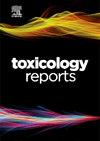Anticholinergic syndrome due to mydriatic drops intoxication in a child: A case report
Q1 Environmental Science
引用次数: 0
Abstract
Anticholinergic syndrome consists of neurological and systemic symptoms, including agitation, mydriasis and dryness that can be an adverse reaction to a number of medications, some of them as seemly harmless as cycloplegic mydriatic drops. We present the case of a 7-year-old previously healthy female child who presented to the emergency room with impaired neurological status, inability to recognize family members and incoherent speech, as well as facial flushing, mucosal dryness and bilateral mydriasis after having mistakenly received a high dose of mydriatic drops. She made a complete recovery without need for treatment and had no sequelae. It has been described that anticholinergic syndrome can be related to a number of mydriatic drops (such as cyclopentolate) as well as other medications, in adults, children and neonates. It is a clinical diagnosis and requires no etiological testing. Depending on the severity at presentation, it may be required to administer the antidote physostigmine.
儿童水杨液中毒致抗胆碱能综合征1例报告
抗胆碱能综合征包括神经系统和全身症状,包括躁动、流泪和干燥,这些可能是对许多药物的不良反应,其中一些药物似乎无害,就像麻痹性流泪滴剂一样。我们报告了一名7岁的健康女童,在错误地接受了高剂量的瞳孔滴剂后,因神经功能受损,无法识别家庭成员,言语不连贯,以及面部潮红,粘膜干燥和双侧瞳孔肿大而被送往急诊室。她完全康复,不需要治疗,也没有后遗症。据描述,抗胆碱能综合征可能与一些mydriatic滴剂(如环戊酸酯)以及其他药物有关,适用于成人、儿童和新生儿。这是一种临床诊断,不需要病原学检测。根据出现时的严重程度,可能需要服用解毒剂毒豆碱。
本文章由计算机程序翻译,如有差异,请以英文原文为准。
求助全文
约1分钟内获得全文
求助全文
来源期刊

Toxicology Reports
Environmental Science-Health, Toxicology and Mutagenesis
CiteScore
7.60
自引率
0.00%
发文量
228
审稿时长
11 weeks
 求助内容:
求助内容: 应助结果提醒方式:
应助结果提醒方式:


